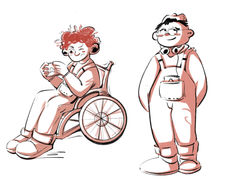Deafblind Teenagers in the Classroom
Jan. 2023 - May 2023
This was a group project that involved working with external partners within my MA. Our project revolved around deafblind teenagers and creating a tool to communicate their experiences to their classmates. We aimed to bridge the gap between deafblind and non-disabled teenagers to help reduce the stigmas around disability. We worked with Deafblind UK, professionals working in the field and the parents of deafblind children to devise a project that could appeal to teenagers, invite co-creation and be developed further in the future.
My teammates for this project were Diana Jiatong Dai, Fruzsina Menyhei, Yu Zhang and Aimee Zhiqi Cao.
Outcome
Our final proposal was to create multi-platform comics. Through these comics, stories could be told that reflect the everyday experiences of deafblind people, the prejudices and challenges they face as well as the joys in their lives. The stories could offer insight and create a guide for non-disabled people.
The stories could take the form of traditional visual comics, Braille comics, animations, and audio book or radio play-style listening experiences. The idea is to maximise accessibility. With the range of vision and hearing varying greatly with each deafblind person, individuals could select the iterations of the story that allow the easiest "reading" for them. This range, and especially the Braille and tactile comics, could give non-disabled people an insight into the world of deafblindness.

Giving voice to people in this community is an aim of this project that can be achieved with co-creation and collaboration. In the future, the stories, ideas and artworks of deafblind teenagers could be applied to this format to bring authenticity and highlight the experiences and voices of this group. The format could be extended to workshops within classrooms, bringing deafblind and non-disabled teenagers together in a creative endeavour.
Process
From the start, we knew we wanted illustration to play a central role to the project. However, we knew little about the world of deafblindness and began the project with extensive research, listening to the stories of people with deafblindness, discovering deafblind artists and researching the resources available to the community.
I noticed that the words "superhero" and "superpower" were often used in relation to deafblindness and our initial idea was to develop a team of deafblind superheroes. In the context of collaboration, workshops could be established with teenagers creating their own superheroes, and we could work together to tell a story about the struggles and triumphs of deafblindness.

However, as we began to develop the idea, we were able to contact the parents of deafblind teenagers. We received feedback that indicated a focus on everyday and practical issues would be preferred. We therefore pivoted to portraying real-life scenarios in our comics. Our partners liked the idea of the superheroes and, with the development of our multi-media comics, I believe this idea could be returned to in the future.
I wrote a series of scripts based on the accounts I had read and heard of deafblind people. The idea we decided to expand upon for the final presentation revolved around the exhaustion of having to constantly introduce oneself and explain ones disability. The comic acts as insight and teaching-tool. Within our work, it was interesting to see the story applied to various visual languages and comic-styles, as well as my (difficult to photograph) experiments with Braille and tactile surfaces.

















